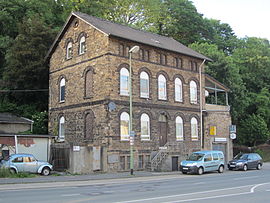Johann Deimelsberg colliery
| Johann Deimelsberg colliery | |||
|---|---|---|---|
| General information about the mine | |||
| Former factory building on Westfalenstrasse (under monument protection) | |||
| Funding / year | approx. 420,000 t | ||
| Information about the mining company | |||
| End of operation | 1928 | ||
| Successor use | Commercial space | ||
| Funded raw materials | |||
| Degradation of | Hard coal | ||
| Geographical location | |||
| Coordinates | 51 ° 26 '30.8 " N , 7 ° 3' 43.2" E | ||
|
|||
| Location | Steele | ||
| local community | eat | ||
| Independent city ( NUTS3 ) | eat | ||
| country | State of North Rhine-Westphalia | ||
| Country | Germany | ||
| District | Ruhr area | ||
The bill Johann Deimel Berg was a coal - mine in Essen - Steele .
history
Under the name Union of the Johann Deimelsberg colliery , two collieries came together between 1885 and 1887 , which had been mining coal in the area west of Steele for a long time .
A gallery called Deimelsberg was mentioned as early as the 16th century. The Deimelsberg tunnel from which the colliery originated was documented since 1749. From 1829 the mine was run as an inheritance tunnel. In 1853, the lowering of the first seigeren shaft began directly on Deimelsberg. After 1870 the mine was renamed Ver. Deimelsberg led. The shaft Deimel Berg 1 was near the Westfalenstraße sunk . In 1876, the Deimelsberg 2 shaft was sunk on Laurentiusweg . After the start of production , the Deimelsberg 1 shaft was dropped and only processing was carried out. The production reached 90,000 tons of lean coal per year.
The Johann colliery was founded in 1809 and initially mined coal in the area at the west end of Steele with tonnage (= inclined) shafts. From 1859, the mine field property was enlarged by connections, so that the colliery in the future as Ver. Johann traded. In 1873, the first vertical (vertical) shaft was sunk near the Steeler Westbahnhof . After digging down a weather shaft, 130,000 tons of coal were produced each year. After the two mines merged in 1887, production was gradually shifted to the Johann mine. In 1893 a briquette factory was built on Schacht Johann .
1906 was next shaft Johann 1 of the shaft 2 Johann drilled. After its completion, the Deimelsberg 2 shaft was finally dropped and filled . Shaft Johann 1 received a new headframe . In 1910 the mine field was connected to the closed coal mine United Charlotte . From 1915 this was transferred to the newly founded Charlotte Bergbau GmbH , which planned to resume mining (see Theodor colliery ).
Shutdown
From 1919 the mine was owned by Bergbaugesellschaft Adler mbH . This planned to connect the colliery, which was in financial difficulties due to the difficult sales situation for lean coal, with the neighboring lean coal mine Centrum 4/6 . A link has been opened. At that time, Johann Deimelsberg produced 420,000 t of lean coal annually. In fact, however, it turned out in 1926 that this network was not economically viable. Therefore, the Johann 1/2 conveyor system was taken out of service in 1928 and the mine closed on August 31st. The shafts were filled and the daytime facilities demolished. From 1952 the mine field was opened up and dismantled by the neighboring Katharina colliery .
Transit camp
In April 1942, around 300 Jewish residents of Essen were concentrated in the Holbeckshof barrack camp, which served as a transit camp . The camp was guarded, but the residents were able to stay outside during the day with restrictions. 170 of the Jews listed in a house residents' register were deported to the Theresienstadt ghetto on July 20, 1942 .
Current condition
The site of the Deimelsberg colliery had already been abandoned at the turn of the 20th century. In the 1920s, the Essen-Steele Knappschaftskrankenhaus was built on the Deimelsberg 1 site. There are businesses on the Johann 1/2 site .
A colliery building on Westfalenstrasse still exists and has been a listed building since 1991.
literature
- Wilhelm Hermann, Gertrude Hermann: The old mines on the Ruhr. 6th expanded and updated edition, Verlag Karl Robert Langewiesche, successor Hans Köster KG, Königstein i. Taunus 2006, ISBN 3784569943
Individual evidence
- ↑ List of residents of the property: Holbeckshof , in: Hermann Schröter (Hrsg.): History and fate of the Essen Jews: Memorial book for the Jewish fellow citizens of the city of Essen . Essen: City of Essen, 1980, pp. 432–458
- ↑ Excerpt from the list of monuments of the city of Essen (PDF; 649 kB); Retrieved January 5, 2017

